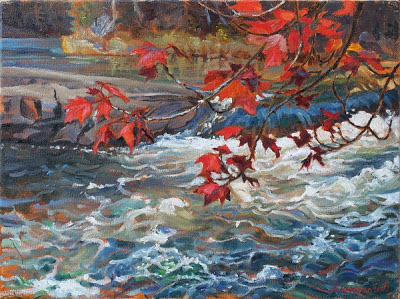Beautiful Imperfections (oil on canvas 5 x 7 in.)
For sale at Burlington Art Centre $425 framed
14 August finds us crouched beside some mushrooms under Firs and Maples at the western tip of Antinouri Lake in the Jacquet River Gorge NPA, New Brunswick.
There are three large brown mushrooms, and Adam is doing a watercolour of all three, beside the log that overshadows my closer view. They are satiny-capped and perfect, except for a pale leaf-print on the cap of the larger, which I find charming. Also pleasing my artist's eye is the yellow mottling on leaves to the left, and the various spots and holes on the long smooth leaves of Queens Cup Lily and on the parallel veined Bunchberry.
The yellow mottling may be due to a fungus that operates within the tissues of the leaf. It has been estimated that there are some ten million species of that kind of fungus in the world. Without these imperfections my painting would be a cartoon of coloured shapes and planes, but thinking in terms of biodiversity, the blemishes are evidence of the kinds of active complexity that keep a flowing, shifting balance in the web of life.
Each imperfection indicates the presence of an unseen species, signs that the individuals that we can see and name are part of a deeper community, each dependent on the others in some way, from vascular plants, lichens, fungi, algae, invertebrate and vertebrate animals, to the vast unseen galaxy of simple and single-celled organisms. And each imperfection indicates the presence of another species.
Considering all of this, we realize the inadequacy of a BioBlitz. For example, there is no arachnologist among the specialists here, so each of us feels a certain pang when a spider goes unrecognized. We have the North American expert in stubbly lichens, the Ecologist who explored and helped to identify New Brunswick's Protected Natural Areas, an eminent fish specialist, the most prominent dragonfly expert in eastern Canada, and students who are doing their Masters theses on bats and other small mammals, two butterfly experts, a parasitologist, a couple of herpetologists, botanists, and many of these are excellent general naturalists. But we still feel inadequate in our coverage of the biodiversity and the geographical extent of this 26,000 hectare area set aside for protection from commercial exploitation.
When Adam and I finished painting these two mushrooms we picked them to take them back to the lab for identification. The tough, thick creamy stems were broader at the base, and banded with orange-red, also bruising that colour as we handled them. The mushroom specialist confirmed our field guide identification as the Baned Cort, Cortinarius armillatus.
Adam and I enjoyed comparing our paintings, oil closeup and watercolour overview.
14 August finds us crouched beside some mushrooms under Firs and Maples at the western tip of Antinouri Lake in the Jacquet River Gorge NPA, New Brunswick.
There are three large brown mushrooms, and Adam is doing a watercolour of all three, beside the log that overshadows my closer view. They are satiny-capped and perfect, except for a pale leaf-print on the cap of the larger, which I find charming. Also pleasing my artist's eye is the yellow mottling on leaves to the left, and the various spots and holes on the long smooth leaves of Queens Cup Lily and on the parallel veined Bunchberry.
The yellow mottling may be due to a fungus that operates within the tissues of the leaf. It has been estimated that there are some ten million species of that kind of fungus in the world. Without these imperfections my painting would be a cartoon of coloured shapes and planes, but thinking in terms of biodiversity, the blemishes are evidence of the kinds of active complexity that keep a flowing, shifting balance in the web of life.
Each imperfection indicates the presence of an unseen species, signs that the individuals that we can see and name are part of a deeper community, each dependent on the others in some way, from vascular plants, lichens, fungi, algae, invertebrate and vertebrate animals, to the vast unseen galaxy of simple and single-celled organisms. And each imperfection indicates the presence of another species.
Considering all of this, we realize the inadequacy of a BioBlitz. For example, there is no arachnologist among the specialists here, so each of us feels a certain pang when a spider goes unrecognized. We have the North American expert in stubbly lichens, the Ecologist who explored and helped to identify New Brunswick's Protected Natural Areas, an eminent fish specialist, the most prominent dragonfly expert in eastern Canada, and students who are doing their Masters theses on bats and other small mammals, two butterfly experts, a parasitologist, a couple of herpetologists, botanists, and many of these are excellent general naturalists. But we still feel inadequate in our coverage of the biodiversity and the geographical extent of this 26,000 hectare area set aside for protection from commercial exploitation.
When Adam and I finished painting these two mushrooms we picked them to take them back to the lab for identification. The tough, thick creamy stems were broader at the base, and banded with orange-red, also bruising that colour as we handled them. The mushroom specialist confirmed our field guide identification as the Baned Cort, Cortinarius armillatus.
Adam and I enjoyed comparing our paintings, oil closeup and watercolour overview.





Comments
Post a Comment
What do you think of this painting, and what do you know about the subject that I have painted?